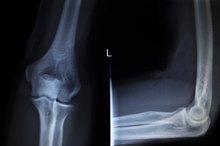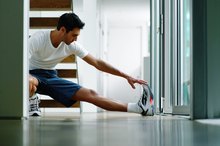Rectus Abdominis Muscle Injury
The rectus abdominis is a large muscle in the center of your abdomen that extends from your ribs to the front of your pubic bone. Injuries to this muscle result in varying degrees of abdominal strain. Minor strains result in stretching of the rectus abdominis, while major strains result in complete ruptures or tears and may also trigger bleeding and the formation of an abdominal hernia.
Rectus Abdominis Basics
Your rectus abdominis is one of four components of your abdominal musculature, according to MD Guidelines. The other abdominal muscles are the transversus abdominis, which sits deep in your abdomen, and the internal and external obliques, which sit in pairs on either side of the rectus abdominis. The primary purpose of the rectus abdominis is to allow you to move the portion of your body between your pelvis and ribcage, the Better Health Channel reports. When viewed externally, it forms the classic “six-pack” of a well-toned abdomen.
- Your rectus abdominis is one of four components of your abdominal musculature, according to MD Guidelines.
- The primary purpose of the rectus abdominis is to allow you to move the portion of your body between your pelvis and ribcage, the Better Health Channel reports.
Causes
Groin & Hip Pain Upon Standing & Walking
Learn More
Although it is possible to strain other muscles in your abdomen, most abdominal strains involve your rectus abdominis, MD Guidelines reports. You have a particularly high risk of straining your abdomen if you engage in physical labor or athletic activities. Labor-related causes of a strain include sudden twisting motions or the lifting of heavy objects. Athletics-related causes include pole-vaulting, weightlifting, swimming the breaststroke, performing sit-ups and engaging in skating or hockey. If you are overweight or out of shape, you may also develop an abdominal strain if you perform physical activities without proper preparation. In some cases, prolonged or energetic sneezing or coughing may also trigger an abdominal strain.
- Although it is possible to strain other muscles in your abdomen, most abdominal strains involve your rectus abdominis, MD Guidelines reports.
- If you are overweight or out of shape, you may also develop an abdominal strain if you perform physical activities without proper preparation.
Levels of Injury
Abdominal strains come in three levels or degrees, MD Guidelines explains. If you develop a first-degree strain, your rectus abdominis will be abnormally stretched but intact. In a second-degree strain, stretching is severe enough to trigger a partial muscle tear. Individuals with a third-degree abdominis strain have a complete tear that frequently involves separation of the muscle from one of its associated tendons. If you have a third-degree strain associated with a tear in your abdominal wall, you may also develop a hernia, a condition characterized by the abnormal protrusion of your intestines or connective tissue through your rectus abdominis or other abdominal muscles.
- Abdominal strains come in three levels or degrees, MD Guidelines explains.
- If you develop a first-degree strain, your rectus abdominis will be abnormally stretched but intact.
Symptoms
Torn Tendons & Ligaments From Hyperextension
Learn More
The Cleveland Clinic lists potential symptoms of an abdominal strain that include pain during vigorous activity such as striking a ball or running, stiffness after prolonged sitting and pain while coughing, sneezing or laughing. In many cases, you will feel a gradual onset of symptoms that does not stop you from performing everyday activities. If your strain continues to worsen, however, your injury may eventually disrupt your daily routine. Your symptoms may worsen when you contract your abdominal muscles, MD Guidelines notes.
- The Cleveland Clinic lists potential symptoms of an abdominal strain that include pain during vigorous activity such as striking a ball or running, stiffness after prolonged sitting and pain while coughing, sneezing or laughing.
- In many cases, you will feel a gradual onset of symptoms that does not stop you from performing everyday activities.
Treatment
If you have a first- or second-degree strain, potential treatments include rest, alternating application of cold and heat and compression of your abdomen with a bandage or corset, according to MD Guidelines. If you do not develop bleeding or bruising, you can also use a nonsteroidal anti-inflammatory painkiller. A third-degree strain may necessitate a surgical reconstruction or repair.
Related Articles
References
Writer Bio
M. Gideon Hoyle is a writer living outside of Houston. Previously, he produced brochures and a wide variety of other materials for a nonprofit educational foundation. He now specializes in topics related to health, exercise and nutrition, publishing for various websites.









